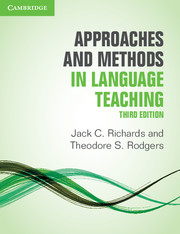Book contents
- Frontmatter
- Contents
- Acknowledgments
- Introduction to the third edition
- I Major trends in twentieth-century language teaching
- II Current approaches and methods
- III Alternative twentieth-century approaches and methods
- IV The teaching and learning environment
- Appendix: Comparison of approaches and methods
- Author index
- Subject index
5 - Communicative Language Teaching
Published online by Cambridge University Press: 08 April 2022
- Frontmatter
- Contents
- Acknowledgments
- Introduction to the third edition
- I Major trends in twentieth-century language teaching
- II Current approaches and methods
- III Alternative twentieth-century approaches and methods
- IV The teaching and learning environment
- Appendix: Comparison of approaches and methods
- Author index
- Subject index
Summary
Introduction
The development of Communicative Language Teaching
There are two interacting sources of influence that shape the field of language teaching, which have accounted for its recent history and which will no doubt determine the direc-tion it takes in years to come. One comes from outside the profession and reflects the changing status of English in the world. Increasingly, essential features of contemporary societies are an English-proficient workforce in many key sectors of the economy as well as the ability of people from all walks of life to access the educational, technical, and knowl-edge resources that proficiency in English makes available. Consequently, in recent years there has been a dramatic change in the scope of English language teaching worldwide and, as a result, growing demands on those charged with providing an adequate response to the impact of the global spread of English. There is increasing demand worldwide for language programs that deliver the foreign language skills and competencies needed by today's global citizens and a demand from governments for more effective approaches to the preparation of language teachers. At the same time, there has often been a perception that language teaching policies and practices are not providing an adequate response to the problem. Hence, the regular review of language teaching policies, curriculum, and approaches to both teaching and assessment that has been a feature of the field of language teaching for many years.
The second source of change is internally initiated, that is, it reflects the language teaching profession gradually evolving a changed understanding of its own essential knowl-edge base and associated instructional practices through the efforts of applied linguists, specialists, and teachers in the field of second language teaching and teacher education. The language teaching profession undergoes periodic waves of renewal and paradigm shifts as it continually reinvents itself through the impact of new ideas, new educational philoso-phies, advances in technology, and new research paradigms, and as a response to external pressures of the kind noted above. The movement and approach known as Communicative Language Teaching (CLT) is a good example of how a paradigm shift in language teaching reflects these two sources of change.
- Type
- Chapter
- Information
- Approaches and Methods in Language Teaching , pp. 83 - 115Publisher: Cambridge University PressPrint publication year: 2014



